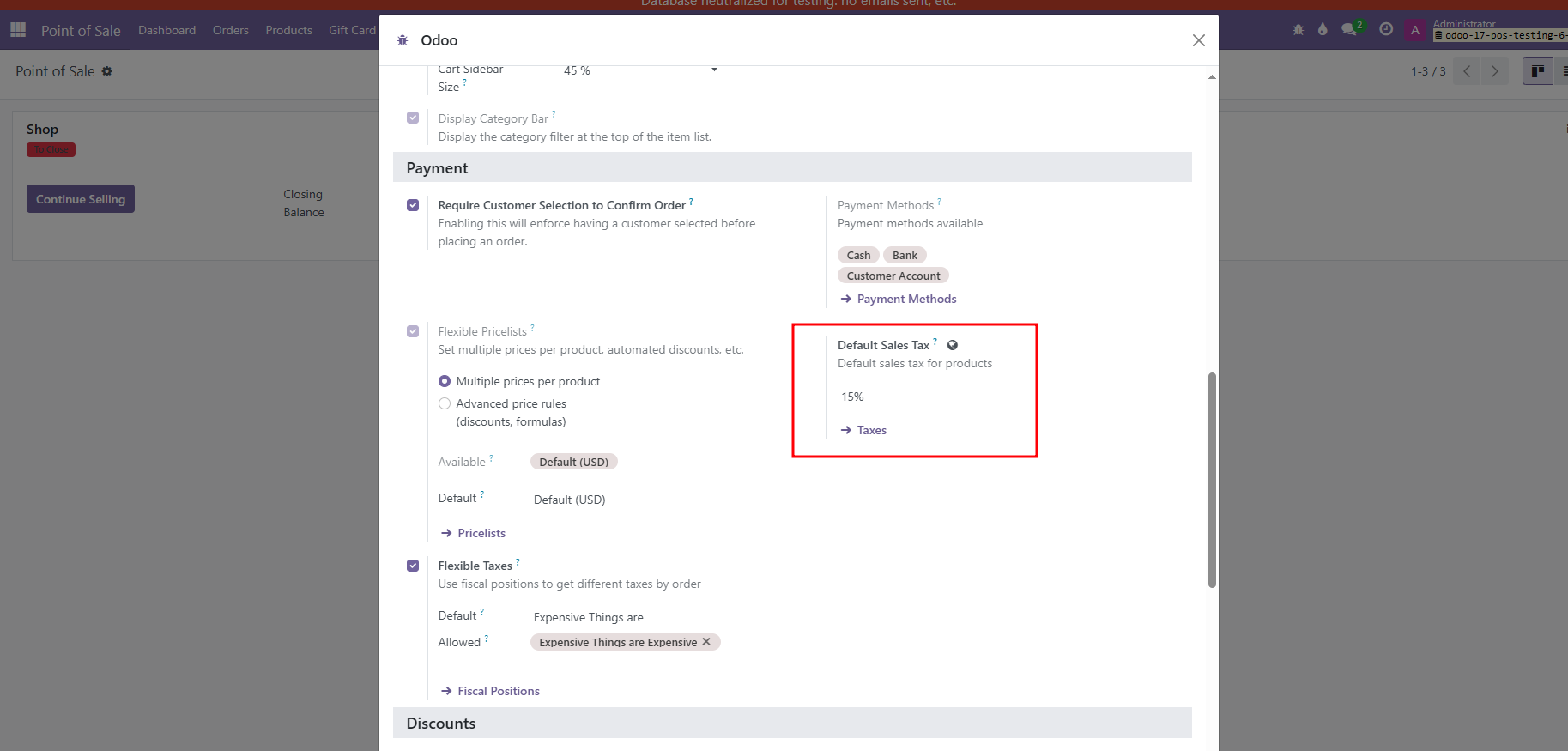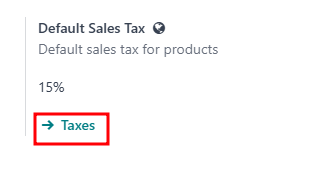Tax Setup
Taxes
There are numerous types of taxes, and their application varies greatly, depending mostly on your company’s localization. To make sure they are recorded with accuracy, the POS’s tax engine supports all kinds of uses and computations.
Default taxes
Default taxes define which taxes are automatically set when creating a new product.

To change your default taxes, go to the Point of Sale app Configuration tab > Settings, scroll to the 'Accounting' section and find the 'Default Sales Tax' field; select the appropriate taxes for your default sales tax, and click on 'Save'.


NOTE: The below method to modify default taxes will be available in a future quality of life update to the POS, coming soon. Please use the method above at this current time.
To change your default taxes, go to the Point of Sale settings menu > Payment > Default Sales Tax, select the appropriate taxes for your default sales tax, and click on 'Save'.
Default taxes are automatically set up according to the country selected at the creation of your database. It will need to be changed to match your state's actual policy.
Configuration
To edit or create a tax, click on the 'Taxes' button beneath 'Default Sales Tax' and open a tax or click on New.

Basic options
Tax name
The tax name is a non-technical name to displayed to backend users in the Taxes field in invoices, product forms, etc.
Tax computation
-
Group of Taxes
The tax is a combination of multiple sub-taxes. You can add as many taxes as you want, in the order you want them to be applied.
Make sure that the tax sequence is correct, as the order in which they are may impact the taxes’ amounts computation, especially if one of the taxes affects the base of the subsequent ones.
-
Fixed
The tax has a fixed amount in the default currency. The amount remains the same, regardless of the sales price.
Example
A product has a sales price of $1000, and we apply a $10 fixed tax. We then have:
|
Product sales price |
Price without tax |
Tax |
Total |
|---|---|---|---|
|
1,000 |
1,000 |
10 |
1,010.00 |
-
Percentage of price
The sales price is the taxable basis: the tax amount is computed by multiplying the sales price by the tax percentage.
Example
A product has a sales price of $1000, and we apply a 10% of Price tax. We then have:
|
Product sales price |
Price without tax |
Tax |
Total |
|---|---|---|---|
|
1,000 |
1,000 |
100 |
1,100.00 |
-
Percentage of Price Tax Included
The total is the taxable basis: the tax amount is a percentage of the total.
Example
A product has a Sales Price of $1000, and we apply a 10% of Price Tax Included tax. We then have:
|
Product sales price |
Price without tax |
Tax |
Total |
|---|---|---|---|
|
1,000 |
1,000 |
111.11 |
1,111.11 |
Active
Only active taxes can be added to new documents.
It is not possible to delete taxes that have already been used. Instead, you can deactivate them to prevent future use.
Taxes can be made inactive from the overview list of all taxes.
Tax type
The Tax Type determines the tax application, which also restricts where it is displayed.
-
Sales: Customer invoices, product customer taxes, etc.
-
Purchase: Vendor bills, product vendor taxes, etc.
-
None
You can use None for taxes that you want to include in a Group of Taxes but that you do not want to list along with other sales or purchase taxes.
Tax scope
The Tax Scope restricts the use of taxes to a type of product, either goods or services. Service products may include clothing alterations, gift wrapping, or the like.
Advanced options tab
Label on invoices
The tax label is displayed on each invoice line in the Taxes column. This is visible to front-end users on exported invoices, in customer portals, etc.
This field is not relevant when only using Rooteam's Point of Sale and may be left blank if desired.

Tax group
Select which tax group the tax belongs to. The tax group name is the displayed above the total line on exported invoices and in customer portals.
Tax groups include different iterations of the same tax. This can be useful when you must record the same tax differently according to fiscal positions.
Example

Taxes have three different labels, each one having a specific use. Refer to the following table to see where they are displayed.
|
Tax Name |
Label on Invoice |
Tax Group |
|---|---|---|
|
Backend |
Taxes column on exported invoices |
Above the Total line on exported invoices |
Included in price
With this option activated, the total (including the tax) equals the sales price.
Total = Sales Price = Computed Tax-Excluded price + Tax
Example
A product has a sales price of $1000, and we apply a 10% of Price tax, which is included in the price. We then have:
|
Product sales price |
Price without tax |
Tax |
Total |
|---|---|---|---|
|
1,000 |
900.10 |
90.9 |
1,000.00 |




